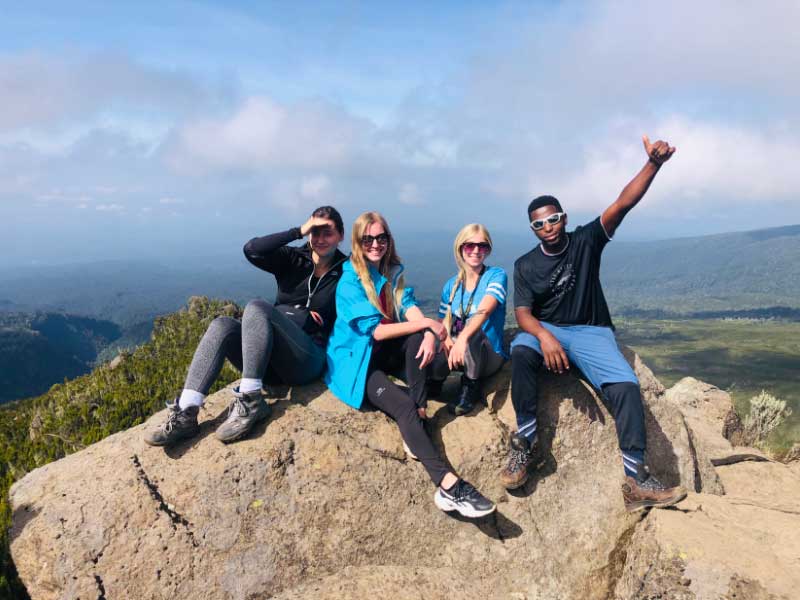Mountain Climbing Packing List
- Home
- Kilimanjaro Climb Tips
What gear and clothing to pack for Kilimanjaro
Our Kilimanjaro experienced team will do a full and thorough check of your equipment before you leave for your trek. If you need special gear or have forgotten anything at home, you can rent it from us on site.
Gear list
- Pack a duffel bag or backpack. No suitcases! Porters carry these bags on their heads and the weight must not exceed 12kg.
Your backpack will be packed inside special trekking bags, manufactured especially for us in Tanzania. - Trekking poles help. If you don’t have your own, you can rent them from us.
- Some people prefer to use gaiters to keep their shoes drier or especially for downhill sections where the surface is gravelly. Gaiters can be rented quite cheaply, but are not a must.
- A good day pack to carry your extra layers, water, and some snacks is essential.
- No PET plastic bottles are allowed on Kilimanjaro. Bring aluminum or Nalgene-type bottles for water. Camelbacks are handy as well, but water will freeze especially on summit night so you will need bottles. You will need to drink at least 3 liters of water per day.
- High-factor sunscreen, lip balm, and polarised sunglasses are essential.
- Pack a headlamp and two sets of extra batteries.
- Bring snacks such as dried fruit, nuts, sweets, energy bars, and powdered energy mix for the water in your day pack.
- Toiletries should not be much more than a toothbrush, toothpaste, deodorant, wet wipes, and toilet paper. Most operators provide soap, but porters supply just enough water to wash your face. Our team recommends a nail brush and a nail cutter to keep toenails short. Remember a light travel towel. Anything else will not dry. For women: bring what you need as the altitude can influence your monthly cycles.
- Cameras and their batteries are severely impaired by the cold and high altitudes. Bring spare batteries and memory cards.
- A good first-aid kit is essential.
- A deck of cards or a book is useful to while away free time.
Other useful items include duct tape and a pocket knife.
Clothing list
You’ll need to be well-prepared for temperatures potentially ranging from 30 Degrees Celsius at the bottom of your route to -20 Degrees Celsius at the top. Make sure to account for the full range.
- Take thermal underwear, top, and bottoms. It may not be pretty, but it will keep you warm.
- Pack two light fleece tops and one thicker fleece. The best type of fleece is breathable. This will ensure moisture is drawn away from your body.
- Block the wind with a good quality shell. Try it on over your fleeces. You can rent this if you don’t have one.
- Get good quality trekking pants. Make sure they fit comfortably over your thermal underpants.
- Be waterproof. Good rain protection is extremely important. Once your clothes are wet, it is difficult to dry on the mountain. A waterproof jacket and a light pair of waterproof pants that can be worn over your trekking pants will work fine. Our guides prefer to use umbrellas in the humid forest. Alternatively, a poncho is inexpensive and will keep you and your pack dry in the wet forests as normal rain gear can be too warm.
- Take thermal gloves underneath and use a wind/waterproof pair on the outside.
- Bring a hat with a brim and a good beanie. A fleece beanie is better than a woolen one and dries easier.
- A buff is excellent to keep your neck and face protected and for general versatility
- Do not wear cotton t-shirts once the temperature begins to drop. Sweating will cause it to stick to your body and you will lose heat. Rather opt for quick-drying gym-type tops.
- Wear liner socks to prevent blisters. Good thermal socks are non-negotiable.
- Shorts and a vest may well be handy for the first day’s climb in the warmth of the rainforest
Apart from suitable clothing and lots of layers for keeping warm, you need good hiking boots. Leather is good but can be heavy. Gore-Tex is preferred by many. Do not wear sneakers; you need the ankle support and warmth of proper hiking boots. Most importantly, your boots must be worn in.


We create and run your trip from beginning to end
Helping You to Find a More Authentic, More Exciting & Better Value Safari
To start planning your tour with us, you can create an itinerary from scratch, or modify one of our suggested itineraries. Whether your trip is a few days or a few weeks long, local travel experts will craft a unique itinerary, fully tailored to your wishes. Want to visit a beautiful destination, or start an adventure to reach the top? They will make it happen.
Start Planning Your Next Adventure by Contacting us Today
We have many specials offers especially for your next Tanzania adventure holiday.

